Plastic bottles to greenhouses
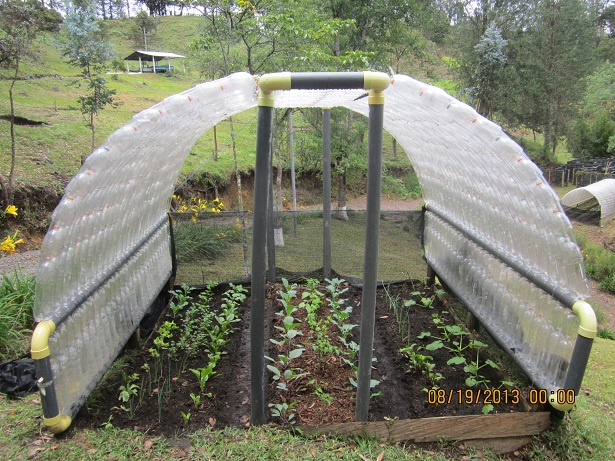 A few days ago we received a very inspiring idea from Colombia. The e-mail came from the Centre for Science and Environmental Awareness and it helps to deal with growing mountains of empty plastic bottles.
A few days ago we received a very inspiring idea from Colombia. The e-mail came from the Centre for Science and Environmental Awareness and it helps to deal with growing mountains of empty plastic bottles.
We learned from the institute’s website that in Colombia an incredibly large amount of 15,000,000 plastic bottles is dumped every day. These bottles are not only thrown into trash bins, they are mainly just thrown away somewhere and this way become a very serious environmental problem.
The Centre for Science and Environmental Awareness tries to tackle the problem. As you can see in the picture, greenhouses are built to grow daily goods. The plastic-bottle-roofs have a size of about 3×3 meters. With only 4 hours work a week the roofs help to feed a family for a whole year, writes Carlos Alberto Yepes Vera, director of the center.
He also calls out to donate bottles or similar garbage to build more of these houses. The project’s goal, he says is also to build an awareness among the population to avoid the use of plastic bottles.
We are extremely grateful to hear from ideas like this one, so send us more of it!
A “die-in” energy protest
It’s the third week of the Reclaim Power Tour, a political bicycle tour, crossing Germany from East to West, covering about a thousand kilometers. Dorothee Häußermann, who’s part of the tour, blogs about meeting different energy activists and an anti-fracking campaign that ends with an unusual protest.
During the tour, we’re visiting different hot spots of a grassroots energy transition: climate camps against open-cast coal-mines, members of the anti-nuclear movement, co-operatives who build their own wind turbines and so on. The aim of the tour is to connect these active local groups in a large network, so we can build a strong movement for a eco-friendly and democratic energy supply that can curb climate change.
We’re curently crossing the state of Lower Saxony. It’s a farming region dotted with small villages and endless corn fields. The area is the focus of various energy companies because of the presence of shale gas reserves in the ground. The companies are currently carrying out test drills to find out if they can exploit the shale gas with a method called ‘hydraulic fracturing’, also known as ‘fracking’. This is a technique in which a mixture of water, sand and chemicals is injected at high pressure into a wellbore to create small fractures in the rock. The sand keeps these fractures open so the gas can be extracted. In recent years, the technique has been at the centre of a highly controversial debate in Germany. There is evidence that the chemicals used in the fracking process could contaminate rivers and drinking water reservoirs.
After 70 kilometres of cycling, we are scheduled to meet a local initiative that is determined to drive away ExxoMobile, a corporation that has been doing test drills in the area. A group of 15 people is awaiting us on the local sports ground where we can put up our tents. They’ve made delicious lentil soup and vegan salads for us, and put sausages on the grill for themselves. The day has been long and hot, and I would love to have a shower, grab one of the beers they are kindly offering, and then collapse in my sleeping bag. But we have some work to do: we are planning a street protest the following day in town that needs preparation. And of course we have to get to know each other, and hear about the people’s fears – about the test drills right in front or below their houses – and about how they have managed to mobilize a large part of the town to take a stance against fracking. And after (temporarily) overcoming my exhaustion, I’m enjoying it. After all, that’s why we are on the road. To get to know local groups, to learn from their expertise, but also, to contribute a new perspective to the discussion: To see fracking as part of an energy system that exploits the last fossil fuels on the planet, in order to keep up an economy that puts growth and profit before the welfare of nature and people. We saw many other sides to the energy debate earlier on the route.
The next morning, we meet at the market square for our”die-in” protest. We offer mock passers-by samples of water with suspicious names, resembling chemicals used in hydraulic fracturing, praising their quality. The bottles are adorned with labels such as “Eau de Frack – con gas – probably not poisonous” or “BioCide – makes you fractive for the day”. Unfortunately, some of the pedestrians collapse after drinking and die on the spot. Opposite our little street performance, the local initiative talks to people and collects signatures for a petition.
After a couple of hours on the market, we pack our bikes and move on. Our next destination awaits us – it’s the next stage of our struggle for a democratic and green energy system.
All routes headed for Frankfurt
This is the third guest post as part of our series accompanying the WWF Youth Bike Tour this summer. Still having sore muscles from the previous day’s leg Tamara Nausner and her fellow cyclists lost little time to ride on to Frankfurt. It was the last stretch for our guest blogger.
Today is a very special day. The bike tour really are two – one that traverses the country passing through the Eastern states, the other following a route in the West. But both will be merging at the end of today’s stretch. Filled with anticipation we are riding out of Wiesbaden, although our bodies hurt quite a bit. But: no pain, no gain. And after a while I get used to it and can enjoy the journey again along the river Main. I like the route more than the one yesterday because for the most part there is no road and no cars. At one point we even have an abandoned motorway all to ourselves. Some of us are cycling as fast as they can. We are all having fun.
We arrive at Frankfurt quite early. The riders from the Eastern route inform us that they will not be here for another few hours. To pass the time we treat ourselves to ice-cream, play cards and relax in the grass near the Main. Eventually the others arrive. Together we take a picture of the banners of the two teams now united.
For me and some of the others the bicycle relay is over now but the rest will ride on in the spirit of climate-friendly travel. I am so glad I took part and hope that there will be another tour next year. And I also hope that we could help encourage people to think about what they can do to protect our environment.
On a highway to hell in Tajikistan
 Our reporter Mareike Aden took the famous Pamir Highway in Tajikistan to a remote region near the Afghan border to shoot a film about a reforestation project. The ride turned out to be long and extremely bumpy, for more reasons than one. Read her blog post to get the story.
Our reporter Mareike Aden took the famous Pamir Highway in Tajikistan to a remote region near the Afghan border to shoot a film about a reforestation project. The ride turned out to be long and extremely bumpy, for more reasons than one. Read her blog post to get the story.
We‘ve been waiting for almost two hours in the heat in front of the damaged bridge and no one knows how long it will take. Behind us and on the other side of the river, the line of SUVs (sports utility vehicles) is growing longer. Several workers are welding slabs and nailing together wooden plankts. Then suddenly our driver jumps back into the car. “Let‘s go,” he says and drives past everyone who‘s waiting in front of us. The bridge sways and rattles but holds. “The others were scared and wanted to see if it collapses,” he says and laughs.
We continue on our way after the unplanned break. We‘re on the Pamir highway that winds its way through the mountains of Tajikistan in Central Asia at an altitude of a few thousand meters. The locals call the highway simply”The Street.” It runs from the Tajik capital Dushanbe and covers a stretch of around 1,200 kilometers through the mountains till the city of Osh in Kyrgyzstan. A large part of the highway, which involves hours of driving, stretches along the Afghan border.
Our destination lies around mid-way on the highway. Khorog is the provincial capital of the mountainous Tajik region of Gorno-Badakhshan on the border to Afghanistan. There, we want to shoot a report about a German-Tajik reforestation project.
 “Around 15 hours,” is what our driver said when we left from Dushanbe in the morning. Now, it‘s late afternoon and it doesn‘t look like we‘ll be arriving anytime before midnight.
“Around 15 hours,” is what our driver said when we left from Dushanbe in the morning. Now, it‘s late afternoon and it doesn‘t look like we‘ll be arriving anytime before midnight.
By now, I wish I‘d never got to know “the Street.” The battered asphalt stretch is long over. Now we‘re bouncing over an unpaved dirt track along a slope. Our SUV rattles and shakes as we go up and down the narrow bumpy track that snakes around the mountains. When there‘s oncoming traffic, there‘s only one thing that helps – closing your eyes. But you get used to it. Just as you get used to bumping your head against the roof and gripping the door handle to brace yourself for the jolts.
At least the scenery on the other shore of the Pjandsh river distracts me – that‘s where Afghanistan lies and it‘s so close that we can see people in front of their small mud huts, children playing or colorful carpets laid to dry on the shore by the women.
To get into Khorog, home to 20,000 people, that lies on the Afghan border is not easy. Either you can take “the Street” or the allegedly most dangerous flight route in the world – thorough the Pamir mountains. It‘s said that during the Soviet era, pilots got paid an extra “risk bonus” for flying there.
Until today, small propeller-driven planes operated by Tajik Air fly to the region, but only on days when there are no clouds in the sky. We opted for a car because we really wanted to arrive there – whatever that means.
But I swear to myself that I will take a plane back after we arrive in Khorog at night after a 16-hour drive. Even our local driver who was in such a good mood to start with turned ever more silent towards the end. And the next day, my camerman Yurij admitted to me that he had secretly made emergency plans in case we‘d had an accident.
Three days later, we awere finished with our film shoot and in possession of two hotly coveted tickets for the small plane back to Dushanbe. But then – clouds appeared on the horizon. We had no choice but to get back into the car and back on the Pamir Highway.
But this time, all the bridges were intact, the rivers that our SUV had to drive through were not flooded – and after just 12 hours, we arrived in Dushanbe. “The Street” no longer seemed terrifying to us, well almost.
56 Kilometers turn strangers into friends
This is the second guest post as part of our series accompanying the WWF Youth Bike Tour this summer. Today Tamara Nausner tells us about her day on the road – and that 56 kilometers on a bike need not be the most taxing thing in a day of cycling…
My day starts very early in the morning. Too early. But today there is no time to be tired or lazy. So I’m packing all my luggage onto my bike and ride to the train station. It is so quiet and peaceful at this time in the morning.
Being a little late, my train eventually is on its way to Oberwesel – the starting point for today’s stage of the WWF Youth cycling tour.
What I learn along my journey is that there are no elevators at small stations, so I have to carry my bike up and down the stairs quite a few times. Not that easy with all the luggage.
At half past nine I arrive in the town, which is is located some 80 kilometers West of Frankfurt. I am very excited to meet the two cyclists, who will join me for the tour. And they don’t keep me waiting. I spot them immediately – they are wearing the vests carrying the WWF logo. Then they hand me one, too. Time for a picture of all of us! There is not much around; we eventually opt for an old ruin as a backdrop for our photo.
At last we start day 20 of our tour, which today will bring us to the city of Wiesbaden. But we are not the only ones on the road, framed by vineyards on one side and the river Rhine on the other. Unfortunately there are cars too. So after a while we decide to take a route through the vineyards. There are no other cyclists and no cars. Only a tractor. But very quickly we regret this idea because our path is steeply rising. Eventually we return to our previous route.
The weather is perfect: warm but not too hot, clouds and the sun take it in turns. We enjoy the journey. While riding we get to talk a bit, about everything, and I realize how nice it is to talk to people who have similar interests – protecting the environment being a very big one.
Our destination is getting closer. But before starting off on the final stretch we decide to take a break and have some lunch. That is when I notice for the first time just how tired I am. The rest of the trip is quite tough. Finally we arrive at the train station of Wiesbaden. But even after 56 kilometers on the bike there is no rest for us yet. A photographer is welcoming us, asks for our names and wants to take a couple of pictures. Then, he leaves.
A final short ride along a coarse gravel path to our night quarters turns out to be almost the hardest part of our journey today. But eventually we get there.
The next morning at 10am we are ready for the next leg of our tour. We take a picture and are on our way – to Frankfurt.




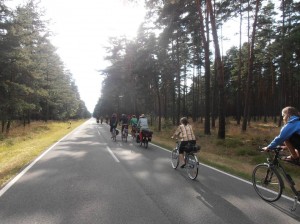
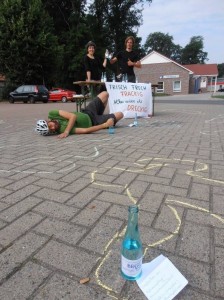
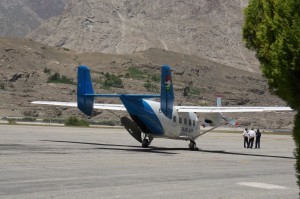

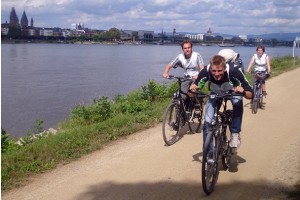




Feedback